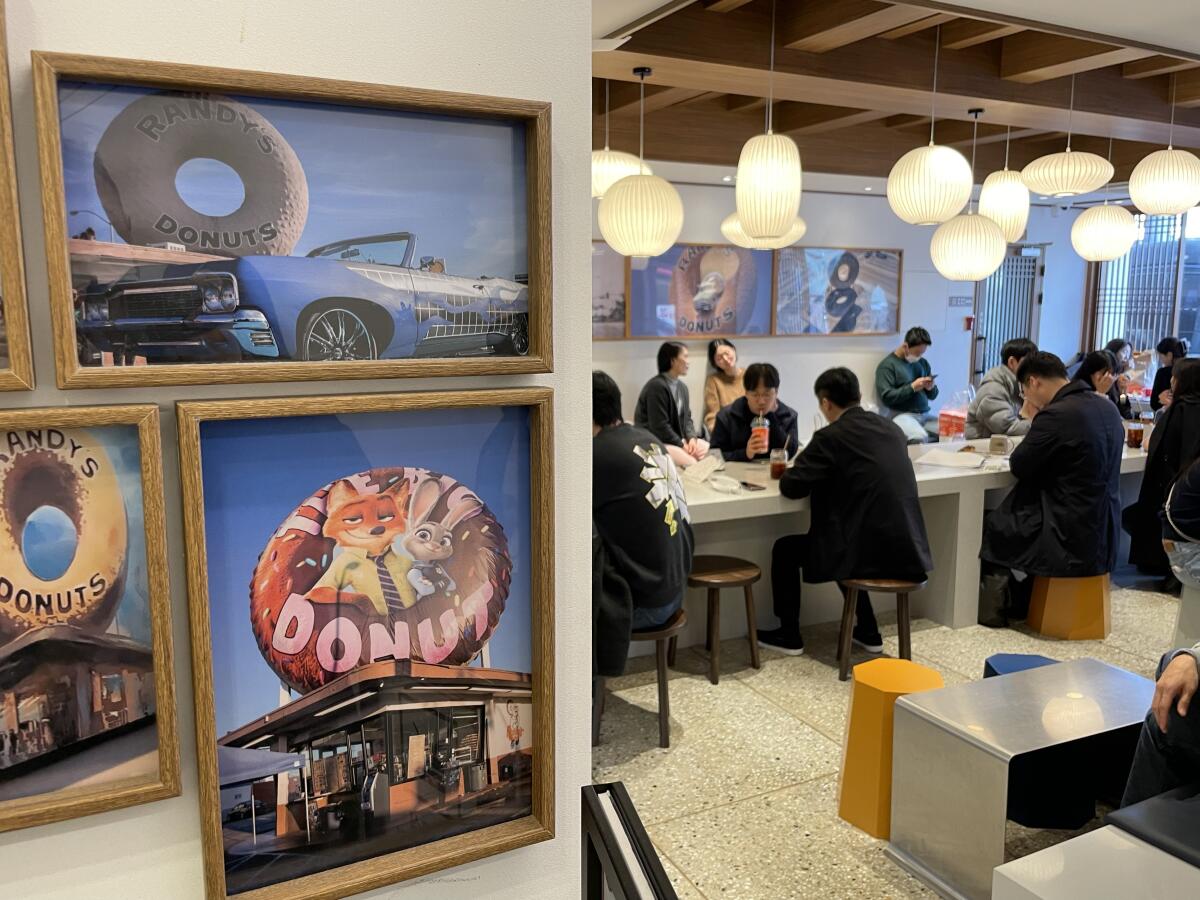Column: A Randy’s Donuts in Seoul adds Los Angeles flavor to South Korea

- Share via
SEOUL — Sometimes you leave Los Angeles only to find that it has arrived at your destination long before you.
A few years ago on a trip to Tokyo I encountered downtown Los Angeles’ Pie Hole in the basement of a train station on my way to try Afuri Ramen, a yuzu ramen specialist.
And this cultural transmission works in both directions. A few weeks ago, not far from the original location of Pie Hole, I had the same bowl of noodles at the new Arts District branch of Afuri Ramen.
So I was more bemused than surprised to find, after 16 hours of travel to visit friends in Seoul, a Randy’s Donuts just a few blocks from my hotel in Korea.
The blocky brown font spelling out “Randy’s” in all capitals was unmistakable. And the giant doughnut — though scaled down to fit in a storefront window — had the familiar disturbingly brown color and mottled texture that I’d never actually want an actual doughnut to have.
The similarities ended there. Randy’s Donuts in Seoul features the sloped tile rooftops found on hanoks, traditional Korean homes. The interior mixed light wood accents and polished white granite tabletops with paper lanterns and wall decor inspired by sliding paper screen doors. In the display case there were the usual maple bars, apple fritters and glazed old-fashioneds; and more recent creations including a cronut-like pastry and a glazed doughnut topped with charred green onion, garlic cream cheese and cheddar.
I washed down my spring onion doughnut with something called an Aewol Ocean Ade, a fizzy blue lemonade topped with a mint leaf.
The main commonality between Randy’s in America and Seoul is the opportunity to be the unwilling backdrop to professionally created social media content. When my friend and I went, we were flanked by a three-person shoot, including lights, tripods and even a costume change. I can’t recall whether the fashionable trio of Korean influencers actually ate the doughnuts they photographed.
By the time I got there, Randy’s in Seoul was old news. There are now five Randy’s Donuts locations in Korea, the first of which opened in August 2019 on Jeju Island, a popular Korean honeymoon destination. Now you can find Randy’s in Costa Mesa, Las Vegas and even Manila. Dunkin’ Donuts and Krispy Kreme have been duking it out in Korea for decades.
History is often lost in the transition from beloved local favorite to global brand. The story of the original Randy’s follows the rise of programmatic architecture and one man’s endearingly bombastic response to Southern California car culture.
Once, 10 gigantic doughnut statues standing more than 20 feet tall loomed over Los Angeles. They lured drivers to locations of the Big Donut drive-in chain, begun in 1950 by Russ Wendell, a former doughnut machine salesman.
After Wendell decided to close down the chain in the 1970s and sold off the locations one by one, at least four monumental doughnuts stayed open under names like Kindle’s, Dale’s and Donut King II.
Randy’s giant doughnut was the most well-known remnant of the chain, perhaps thanks to its location at La Cienega and Manchester boulevards. Neighboring LAX and visible from the freeway, the doughnut stand’s visibility made Randy’s into a ubiquitous cultural icon. Randy’s doughnut has been featured in disaster movies, graced the cover of a J Dilla beat record and cameoed in “Iron Man 2.”
The Randy’s Donut Korea website offers a simplified version.
“Number one donut brand in the United States!”
This viral cultural fluidity has been a part of urban life for nearly a decade now. Grand Central Market’s Eggslut has spread to Seoul as well. And it’s useful to take a step back and think about how weird this new world is. If something is cool anywhere, it will soon appear everywhere. Cities have become more like trending pages, where anything might appear and disappear on a given day.
Randy’s presence in Korea reflects the country’s particular cultural wizardry, which hoovers up hip concepts from all over the globe and creates remixes, replicas and remakes that are so skillfully done that you hardly notice the historical or cultural incongruities. My trip also featured a margherita pizza from a Little Italy-style restaurant replete with stained glass windows and a Korean chef who received an official certification from the Associazione Pizzaiuoli Napoletani in Naples, Italy — surely the world’s foremost authority on Neapolitan pizza authenticity.
You start to wonder, why bother dragging yourself to another country? Just wait long enough, and an algorithmically optimized selection of the world’s most viral foods and experiences will likely appear in your city.
Seoul residents have grown used to the accelerated life cycle of trends. When I met with John Lee, a post-punk musician born in Southern California who lived in Chicago before arriving in Seoul in 2008, he noted that the smashburgers around Seoul had become particularly tasty in the last few years. But easy come, easy go.
“Sometimes there will be this thing that I think is really cool, like, and then I’ll come back a few years later and it’ll be a cosmetics store,” Lee said.
Our culture is so fluid now that geography and history seem superfluous. The past, present and future commingle in a heady, chaotic mixture, and discovering gems has never been more easy and more meaningless. Everything is everywhere, and nothing ever really dies out, nor will anything truly last. Culture has been freed, or stripped, depending on how you feel, of the cumbersome ties to authenticity.
It’s easy to feel disturbed or jaded at all of this. I cannot recommend the spring onion doughnut. But there was a creative energy in Seoul that quickly whittled away my cynicism.
I browsed shops that successfully mingled Midcentury Modern decor with Andy Warhol-esque iconography and a childlike Fisher-Price aesthetic — picture a chrome diner-style Burger King clock and bright red plastic foldout chairs paired with a coffee table of glass and steel.
Diners are a crumbling tradition in the United States, but in Seongsu-dong, which some call Seoul’s Brooklyn, I found dining rooms where the 1950s have never felt more vibrant and alive. So what if they’re serving Japanese curry instead of hash browns?
More to Read
Sign up for Essential California
The most important California stories and recommendations in your inbox every morning.
You may occasionally receive promotional content from the Los Angeles Times.










